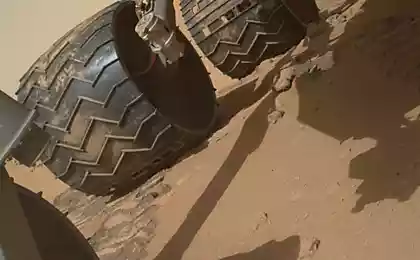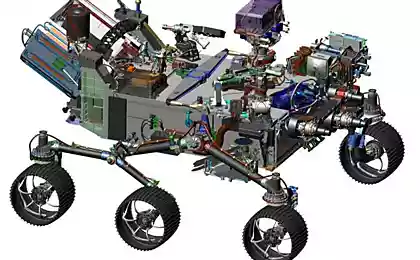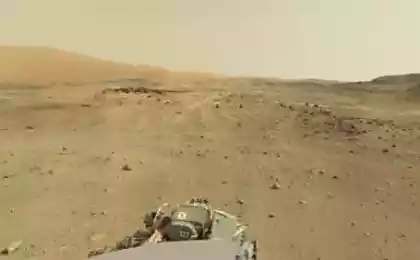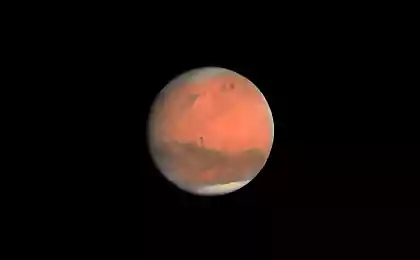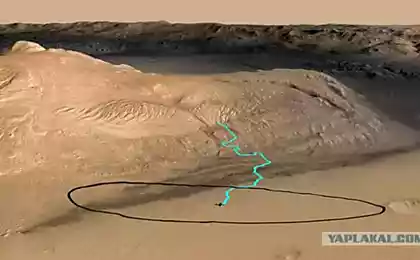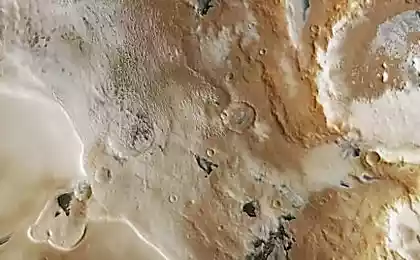911
7 important facts about the rover «Curiosity»

Sixth August Mars Rover landed a new generation, called «Curiosity» - «Curiosity». About its features, differences from existing earlier Mars rovers and on what mission he has to perform, we asked to speak to a senior researcher Vladimir SAI Surdina.
1. The three previous rovers were Americans: small «Sojourner» and two secondary - «Spirit» and «Opportunity». All three are geological devices, there are not installed analyzers biological substance. In the last two were cameras, which showed geologists structure with good resolution and with good spectral range, t. E. Through different filters that allow you to - reliably, but at least in the eyes - to allocate grade rocks, which look. All three were analyzers mineralogical structure, t. E. Crystalline structure which is very much to say about the conditions in which rocks were formed. The problem, of course, was to see whether the water is at a time when the soil was formed, in which the rover travels. And it is possible - found rocks which may be formed only in the presence of water. At least that's what is happening on Earth. Perhaps on Mars so happened, that. E. Indirectly confirmed that Mars once had liquid water.
Pretty good climate investigated as eight years old were monitored continuously in the last two - «Spirit» and «Opportunity». Now we know how the temperature is running across the sky, some sand, some dust flying in the atmosphere at different times of the year in areas where sat phones (near the equator). On Mars varies greatly throughout the year the wind speed, the density of the atmosphere - and now it's pretty well known.
2. «Curiosity» - a large apparatus in the world, he weighs 900 kg; by weight, it even surpassed our "Moon rovers." In «Curiosity» ten times greater than that of its predecessors, the scientific load - just a mass of scientific equipment. Therefore, it is much more advanced devices. For example, the first time to set the remote analyzer chemical composition, ie. E. Will be studied not only to what dotyanet mechanical arm (it is only a two-meter removal). There's an infrared laser that will shoot a short pulse into the rock, evaporate it - to make a small explosion. According to the analysis of the spectrum of this vzryvchika - on the glow of the plasma cloud - you can explore the elemental composition. At the time of the explosion molecules are destroyed and preserved only individual atoms. In geological terms, this would have destroyed the substance, but at least the elemental composition becomes clear. For geologists, he also says a lot about what kind of stuff. Now you can put things on the high slopes of the device or on some deep dips. He dotyanet its laser at a distance of 10-12 meters. This significantly extends the range of studies.

In fact it is the first car that will explore Mars is not two-dimensional, three-dimensional as well. She can climb well, she has a very high cross-country. It is expected to climb the hill and maybe even a few kilometers up the mountain rises. In addition, the devices can also look down into the pit, and up at the slopes of some cliffs. Not very high, about ten meters. Still, this is a three-dimensional scanning, which is very important. If you see some kind of a vertical wall, the geological layers on it tell you the story of the past million years. Previously, geologists have only looked at it through the picture transmitted from Mars, and now may be a laser beam, centimeter by centimeter to measure the chemical composition and to read the geological record.
3. Now on the mobile phone has the biological equipment to search for existing or existed once life. This was the first time, or on one rover not have such devices. They were on Mars only once, when the Americans in 1976, planted two "Viking" - they settled biological complex, but he has shown that there is a sterile surface. On «Curiosity» powerful equipment operating on other principles that can accurately analyze not only chemical but also the molecular composition of substances that fit inside the rover itself with robotic arm and will be able to recognize even torn molecules. On it there chromatograph have x-ray devices for research spectrum and structure of minerals, there is a mass spectrometer, which will also measure the molecular composition. If you've been on Mars complex organic molecules, and from the remaining pieces, they can be fixed. More on nёmest isotopic gas analyzer. The fact that living beings and geological processes can produce the same chemical substances (for example, gases: CO2 or methane), but with a different isotopic composition. During metabolism of life, different isotopes are involved in various ways.
Eighteen months ago, we found that out of the surface of Mars goes methane - a gas or volcanic or animal origin. We have it allocates cattle or microbes under the surface; marsh gas - is also methane. Here we know that methane on Mars, and now we know what its isotopic composition. If there is similar to terrestrial microbes work, it will be possible to prove (or disprove) that a product zhiznedeyatelsnosti, not volcanoes. Volcanoes on Mars should not be, there is pretty cool, and they have frozen billions of years ago. Therefore, there is little doubt that this biogas. But it is necessary to check, and now it can do.
4. On «Curiosity» installed a giant complex of 17 cameras - nothing like this has never happened before. No one has ever led the filming is always passed on static pictures, and in this rover in high definition 10 frames per second will be - the TV picture. He himself can not directly transmit to Earth a large flow, his weak transmitter. He only technical information on the droplets passes. But every day, when over it flies one of the American orbiters (them there are two now works - «Mars Odyssey» and «Mars Reconnaissance Orbiter». That's when one of them passes over «Curiosity», he clears the satellite for a few minutes All that for a whole day recorded his memory. A satellite is already transmitting to us, he has a very powerful channel, Antenna, narrowly directed to the Earth.
Video rover, of course, does not remove all the time. He has two computers are in parallel (just in case), the memory of each of them - only a USB flash drive 2 gigabytes. It's only consumer memory is cheap and great. But on Mars is quite high levels of radiation, so the memory is very special, resistant to radioactivity, and computers very special. And yet, there are two identical set. This is not a lot of memory to install, it is protected specifically, there is a constant duplication, verification of mathematical methods to failures. But 2 gigabytes - is too much! It makes little sense to permanently transfer a movie from Mars. Still, the machine moves slowly such shazhochkami, moving things on Mars, too, is not particularly large. But the video is high quality: frame size of 1600 by 1200, and rich colors. In general, the picture will be much better than previous devices.
5. On a hand-manipulator, which will extend to 2-2.5 meters, has a powerful set of different geological units. Drills, floats, skrebochki microscope pretty good. It is about ten times as a magnifier. E., It is a good geological loop, it can be used to approximate the stones cover - there are several light sources, even UV - and to the geologist is like he walks with a magnifying glass, he brings to his nose pebbles and considers them through it. He sees it as a glittering crystals which there is a surface which colors. Approximately the same was in the previous two devices, but not the quality, simpler. A hand will be drilled stones, abrade the dust, the dust will load into the device, and there in automated laboratories have this dust will be tested for mineral composition, it will be irradiated with alpha particles and X-rays to carry out chemical and X-ray structural analysis, . In general, this is a normal laboratory facilities for the study of the mineral and chemical component of the breed.
For the first time in the rover did not use solar panels and nuclear heat source. There plutonium-238 decays and warm about it with such power as dvuhkilovattny kettle. Compared to the previous Mars rovers this - a giant. It produces 125 watts of electricity to all its engines, all devices is more than enough. And yet - to keep him warm, because Mars is cold at night and many of the rover requires a fairly stable temperature, especially scientific instruments. Here is also the heat generator will give them at night, which is also very important. It is enough to 20-35 years. The radioactive element is gradually losing power, but the half-life in his 88 years, so if all goes well, a few dozen years, the rover will be able to work.
6. On the rover is a very good Russian instrument - about it already told everything. This is the main component of our production, although not the only one. The rocket "Atlas", which launched the rover to Mars, Russian engines are - on the first and second stages. Powerful, good. We have a decent industry in technology that Americans buy and use without a gap - that our engines ... And this priborchik on «Curiosity» called DAN - neutron albedo detector. Albedo - it means reflected. What is he doing? He will be under the irradiated surface rover: a depth of about one meter will produce neutrons, and receive a portion of them in the form of atoms reflected from the ground. If the neutron runs into a heavy particle - nucleus of oxygen, carbon and iron-then it bounces like a ball on the wall. And if a neutron hits the light atom of hydrogen atom, it is no more bounce - like if the ball strikes the ball.
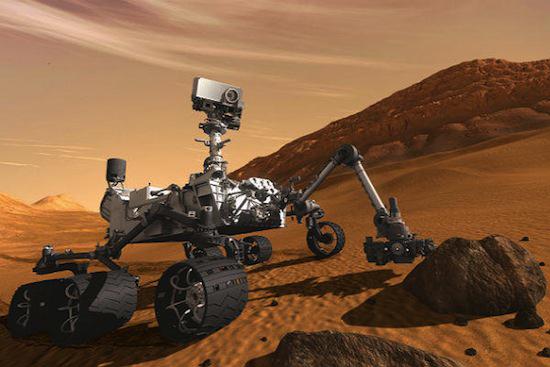
When less reflected neutrons, which means that we have a depth from the surface up to a meter (not visible on) for some lighter material containing most likely hydrogen atoms. Well, that may be a hydrogen atom? Obviously, the water can not think of anything else - hardly there all filled with oil, hydrocarbons. Thus the judge of a layer of ice beneath the surface of the permafrost. And it's very interesting. Until now, this was done only from orbit, but the orbit visible only large areas, and now will be the first time along the route to probe the meter by meter. If you suddenly see that a lot of water under the wheels, you can stop and this robotic arm to dig. Maybe get to the water layers and analyze its composition, it will generally be fine. It seems that it might not be very deep. Previous American unit "Phoenix" four years ago, sat in the high latitudes, about the latitude of our Murmansk. There, on Mars, something similar to the tundra. Digging about 5-7 centimeters, he raked his "hand" layer of snow. But it's in the tundra, and «Curiosity» is now virtually on the equator. It is unlikely that there below the surface at a depth of five centimeters will lay the ice because at the equator of Mars is warm to 15-20 degrees Celsius. But if the machine kopnet 30-40 centimeters (this is my purely intuitive argument), there is already the temperature is always below zero during the day and night, so there is ice may persist. That would be great, because the isotopic composition of the water speaks of its history, where it came from, what was the atmosphere, where it went.
7. A place for landing him get very interesting. This crater, he was named Australian amateur astronomer Walter Gale. The crater is curious in that it has a very low relative to the surrounding surface is the bottom. It seems that when that when the water on Mars was much, the interior of this crater has a lake or the sea. The crater is large - 150 kilometers in diameter, and the center of the crater sticking highest mountain. It is understandable why it is obtained when dripping a drop of water in a glass of water, then out of the center then sometimes jumps a water balloon when voronochka collapses. That's when a meteorite strikes the surface of the planet, it forms the first hole, and then the matter returns to the place, there is a wave of the center and sticks out the underlying rock.
So in the crater Gale is very clearly evident, which means that the rock from the bottom of the lower layers got a meteor explosion. This is very interesting: it is not necessary to dig, and you simply climbing the mountain, get a lot of deep geological layers. «Spirit» and «Opportunity» only on level ground running, on the sand. And then, if the rover will be able to climb this mountain, it layer by layer analyze the deep history of Mars. There are layers were deposited over hundreds of millions of years.
via factroom.ru
The most secure password in the world, you can enter it, but can not remember
10 most bizarre sea creatures



